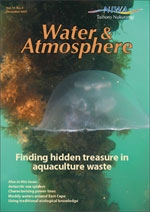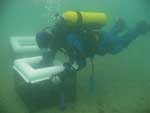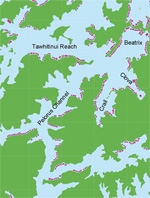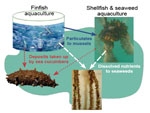PDF of this article (312 KB)




Waste not, want not. Jeanie Stenton-Dozey explains how waste from marine farming offers a way to increase production without enlarging the environmental footprint. The key is integrated co-culture.
The backbone of the New Zealand aquaculture industry has been the longline culture of green-lipped mussels on small coastal farms scattered mainly throughout the Marlborough Sounds. Over the last three decades, farming space has increased more than 30-fold to meet demand for the GreenshellTM brand. In 2006, 97 000 tonnes of mussels, worth $224 million, were harvested from 4747 ha of water space; this represents 90% by weight and 64% by value of New Zealand’s aquaculture production.
But where can the industry go from here? More space for mussels? More mussels per hectare? New species?
The need to boost aquaculture growth beyond an industry dominated by mussel production has been recognised in the NewZealand Aquaculture Strategy (2005), which sets a goal of $1 billion sales by 2025. How? Mussels are a low value product; the price has fluctuated little around an average of $5.10 per kg for annual export returns over the last 20 years (see ‘Valuing seafood’). Stocking densities on existing farms are optimal, so increased profitability can only come from creating more farming space or culturing higher-value species – or by finding innovative ways to increase production per hectare without enlarging the environmental footprint.
Future growth thus lies in making better use of existing space to produce high value sustainable products for export. However such intensification must not be at the expense of the enviable clean, green image of New Zealand seafood. Together with our industry partners, NIWA has taken up this challenge to increase production and value per ha. We’re pioneering the culture of new species and exploring mechanisms to make better use of existing mussel and salmon farming space through integrated co-culture.
What is integrated co-culture?
It’s the scientifically based culture of complementary feeding groups in close proximity for the benefit of the cultured species, the environment, the economy, and society. Integrated co-culture is based on an ancient concept that has been the pivot of aquaculture in China for centuries: the waste from one cultured species is recycled to feed another species.
In recent years, Western nations have been experimenting with co-culture, especially around finfish farms where adding feed has the potential to alter the nutrient pathways in local marine food chains. In Canada, for instance, co-culture research is an integral part of the national Aquanet Research Program, data from which have shown that kelp grows 46% faster and mussels twice as fast when co-cultured with salmon. Research projects underway in Scotland and Denmark show similar results
Integrated co-culture in New Zealand
NIWA’s co-culture research is in collaboration with the Yellow Sea Fisheries Research Institute in China. Through this relationship we’ve built a multidisciplinary team with expertise in research, economics, regulations, and societal concerns. We aim to develop and implement methods for the cost-effective, sea-based culturing of multiple species of high market value. They should be ecologically complementary and able to recycle aquaculture waste. We’re combining mussels with high-value Chinook salmon ($9.20 per kg), sea cucumbers ($15–25 per kg), and two species of seaweed ($ variable per kg) at two research sites in the Marlborough Sounds, one based on salmon as the key culture species and the other on mussels.
Experimental set-up
We monitor the environment and growth of culture species along transects lines around the farms. The water column is analysed for dissolved nutrients and suspended rmaterial, and the amount of material falling to the sea floor is calculated by collections in sediment traps. We determine the influence of the tidal cycle on these parameters from current speed and direction, which are continuously monitored with current meters. Seaweed growth is enhanced by dissolved nitrogenous waste from extraneous fish feed and animal excretion, while the mussels filter particles that are suspended in the water column. Sea cucumbers living on the seafloor feed on deposits that have settled from farm waste.
Seaweeds grown from spores in NIWA’s Mahanga Bay aquarium are planted out on longlines at our research sites. To understand how the seaweeds benefit from farm waste, we experiment with their growth and nutrient uptake rate using different concentrations of dissolved nutrients. Mussels of 20 to 30 mm, provided by industry, are seeded out on ropes using cotton stocking and buoyed longlines. Preliminary data from the salmon farm indicate advanced growth of both mussels and seaweed.
Branching into ranching
Our research on sea cucumbers as a marketable species is based on the premise of sea ranching (where an area is seeded with young animals for future harvest), so we must first ascertain whether these animals concentrate around farm deposits. We’ve placed tagged sea cucumbers under a mussel farm and in areas with no farms; every six weeks NIWA divers return to count the number of tagged animals remaining. Although we’ve had some problems with tag retention, the data clearly show long resident times for sea cucumbers under farms, an excellent result in support of benthic ranching.
At this stage, we’re not sure whether the animals remain under the farms because of food availability or for refuge from predators – or a combination of both. We’ve begun behavioural and feeding experiments to ascertain the relative importance of shelter and food. Mesh cages are placed over the sediment under the farm and hungry sea cucumbers are left in the enclosures for 48 hrs to graze the surface. Then we collect sediment cores for nutrient analysis. These feeding studies are complemented by assessments of feeding behaviour with and without shell debris to see if providing a shelter influences residency time. All these data will be incorporated into ecological and economic models to assess the long-term feasibility of integrated co-culture on small coastal farms in New Zealand.
Clear benefits for the future
Integrated co-culture will yield two clear economic benefits for the aquaculture sector. Firstly, it’s an attractive pathway for diversifying the industry into higher-value species. Secondly, maximising use of natural food, coupled with minimising environmental impact, endows the sector with a significant international marketing opportunity: the market increasingly demands products with low environmental impact, and such products command higher premiums. Co-culture provides a way for New Zealand to capitalise on the global demand for seafood and on the opportunity to increase export earnings through introducing high-value species where we have established networks and market profiles.
Valuing seafood
All prices per kg are for FOB – Free on Board: the value of export goods, including raw material, processing, packaging, storage, and transportation up to the point where the goods are about to leave the country as exports.
Source: NZ Seafood Industry Council, from Statistics New Zealand
Co-culture species in our experiments
Chinook salmon: Oncorhynchus tschawytscha mussels: Perna canaliculus seaweed: Gigartina atropurpurea and Ecklonia radiata sea cucumbers: Stichopus mollis
Mix and match
- Mussels contribute 90% by weight and 64% by value to NewZealand’s aquaculture annual production. How do we move up the value chain from here?
- Co-culture is a way to mix species from different feeding groups in the same space, where the waste of one is food for the other.
- Collaborative research is confirming the suitability of mixing and matching seaweed and sea cucumbers with mussels and salmon.
Further reading and useful links
AquaNet: Canada’s aquaculture research network www.aquanet.ca/English/index.php
Chopin, T. Seaweed and Integrated Multi-Trophic Aquaculture (IMTA)Research Laboratory: www.unbsj.ca/sase/biology/chopinlab
Farming seaweed – a growing industry. Page on the Industrial Research Ltd website:www.irl.cri.nz/newsandevents/innovate/Innovate58/farming-seaweed.aspx
Miller, S. (2007). Land-based polyculture for coastal Māori. Water & Atmosphere 15(1): 22–23.
New Zealand Marine Farming Association Inc. Latest statistics – Aquaculture Industry 2006: www.nzmfa.co.nz/industryinfo.asp
Stenton-Dozey, J. (2007). Balancing ecosystems around mussel farms. National Centre for Fisheries & Aquaculture Update No. 23: 2.
Stenton-Dozey, J. (2007). Tagging sea cucumbers. Water & Atmosphere 15(1): 6.
The New Zealand Aquaculture Strategy is available from Aquaculture New Zealand: www.aquaculture.org.nz
Dr Jeanie Stenton-Dozey studies marine ecosystems and aquaculture, based at NIWA in Christchurch. Her co-culture research is supported by FRST’s International Investment Opportunities Fund (IIOF).
Teachers’ resource for NCEA Achievement Standards or Unit Standards: Biology Level 2 US6309 Economics Level 1 AS90196
